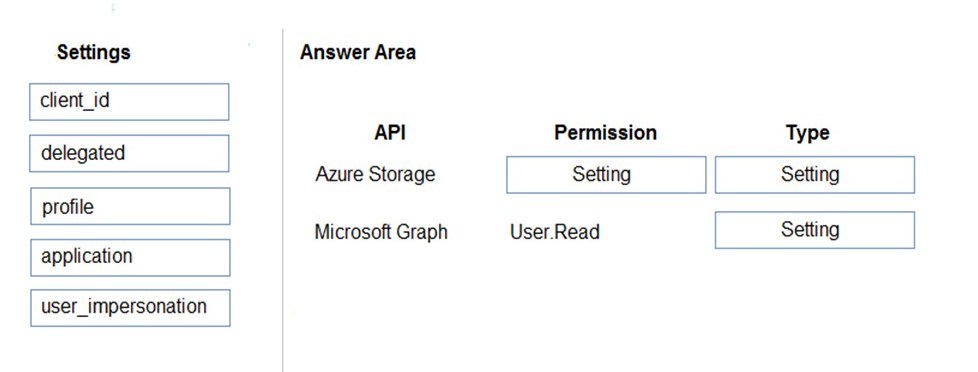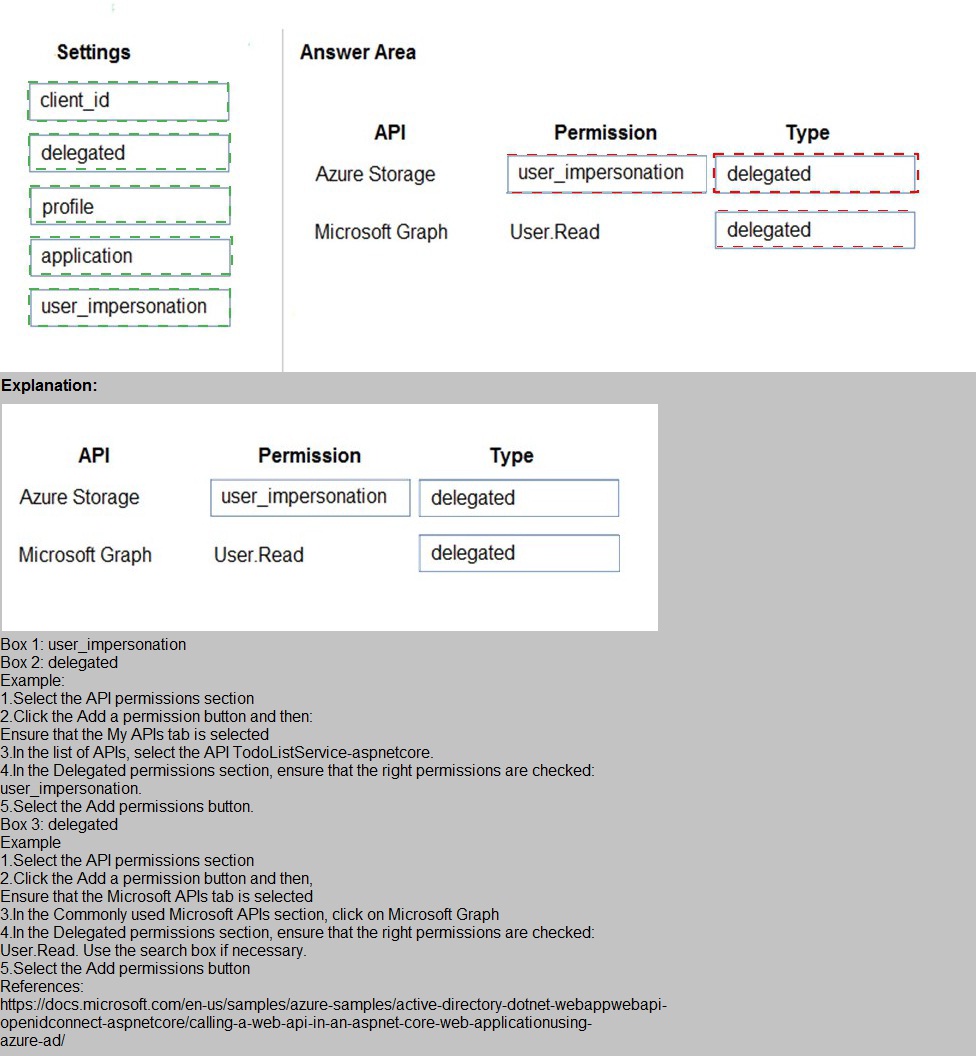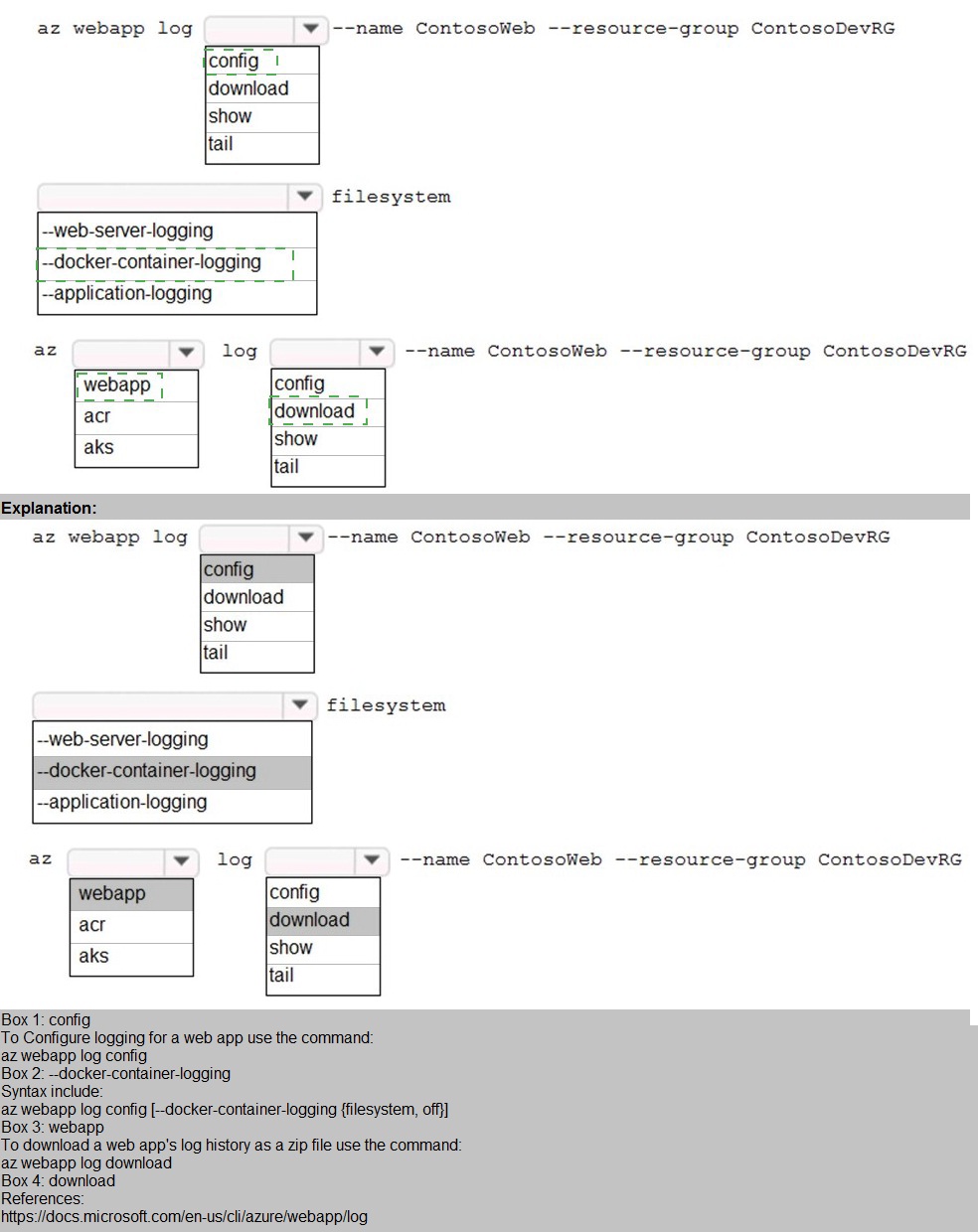
- Email support@dumps4free.com

Topic 4, Misc. Questions
You are developing an ASP.NET Core Web API web service. The web service uses Azure
Application Insights for all telemetry and dependency tracking. The web service reads and
writes data to a database other than Microsoft SQL Server.
You need to ensure that dependency tracking works for calls to the third-party database.
Which two Dependency Telemetry properties should you store in the database? Each
correct answer presents part of the solution.
NOTE: Each correct selection is worth one point.
A.
Telemetry.Context.Operation.Id
B.
Tetemetry.Context.Cloud.Rolelnstance
C.
Telemetry.Id
D.
Telemetry.ContextSession.Id
E.
Telemetry.Name
Telemetry.Context.Operation.Id
Telemetry.Id
Explanation:
References:
https://docs.microsoft.com/en-us/azure/azure-monitor/app/custom-operations-tracking
Example:
public async Task Enqueue(string payload)
{
// StartOperation is a helper method that initializes the telemetry item
// and allows correlation of this operation with its parent and children.
var operation = telemetryClient.StartOperation<DependencyTelemetry>("enqueue " +
queueName);
operation.Telemetry.Type = "Azure Service Bus";
operation.Telemetry.Data = "Enqueue " + queueName;
var message = new BrokeredMessage(payload);
// Service Bus queue allows the property bag to pass along with the message.
// We will use them to pass our correlation identifiers (and other context)
// to the consumer.
message.Properties.Add("ParentId", operation.Telemetry.Id);
message.Properties.Add("RootId", operation.Telemetry.Context.Operation.Id);
Reference:
https://docs.microsoft.com/en-us/azure/azure-monitor/app/custom-operations-tracking
Note: This question is part of a series of questions that present the same scenario. Each
question in the series contains a unique solution that might meet the stated goals. Some
question sets might have more than one correct solution, while others might not have a
correct solution.
After you answer a question in this section, you will NOT be able to return to it. As a result,
these questions will not appear in the review screen.
Margie's Travel is an international travel and bookings management service. The companyis expanding into restaurant bookings. You are tasked with implementing Azure Search tor
the restaurants listed in their solution.
You create the index in Azure Search.
You need to import the restaurant data into the Azure Search service by using the Azure
Search NET SDK.
Solution:
1. Create a SearchServiceClient object to connect to the search index.
2. Create a DataContainer that contains the documents which must be added.
3. Create a DataSource instance and set its Container property to the DataContainer.
4. Set the DataSource property of the SearchServiceCIient
Does the solution meet the goal?
A.
Yes
B.
No
No
Explanation:
Use the following method:
1.Create a SearchIndexClient object to connect to the search index
2.Create an IndexBatch that contains the documents which must be added.
3.Call the Documents.Index method of the SearchIndexClient and pass the IndexBatch.
References:
https://docs.microsoft.com/en-us/azure/search/search-howto-dotnet-sdk
You are developing an ASP.NET Core website that can be used to manage photographs
which are stored in Azure Blob Storage containers.
Users of the website authenticate by using their Azure Active Directory (Azure AD)
credentials.
You implement role-based access control (RBAC) role permission on the containers that
store photographs. You assign users to RBAC role.
You need to configure the website’s Azure AD Application so that user’s permissions can
be used with the Azure Blob containers.
How should you configure the application? To answer, drag the appropriate setting to the
correct location. Each setting may be used once, more than once, or not at all. You may
need to drag the split bar between panes or scroll to view content.
NOTE: Each correct selection is worth one point.


You plan to deploy a web app to App Service on Linux. You create an App Service plan.
You create and push a custom Docker image that image that contains the web app to
Azure Container Registry.
You need to access the console logs generated from inside the container in real-time.
How should you complete the Azure CLI command? To answer, select the appropriate
options in the answer area.
NOTE: Each correct selection is worth one point.

Note: This question is part of a series of questions that present the same scenario. Each
question in the series contains a unique solution that might meet the stated goals. Some
question sets might have more than one correct solution, while others might not have a
correct solution.
After you answer a question in this question, you will NOT be able to return to it. As a
result, these questions will not appear in the review screen.
You are developing a website that will run as an Azure Web App. Users will authenticate by
using their Azure Active Directory (Azure AD) credentials.
You plan to assign users one of the following permission levels for the website: admin,
normal, and reader. A user’s Azure AD group membership must be used to determine the
permission level. You need to configure authorization.
Solution:
•Create a new Azure AD application’s manifest, set value of the groupMembershipClaims
option to All.
•In the website, use the value of the groups claim from the JWI for the user to determine
permissions.
Does the solution meet the goal?
A.
Yes
B.
No
Yes
To configure Manifest to include Group Claims in Auth Token
1. Go to Azure Active Directory to configure the Manifest. Click on Azure Active Directory,
and go to App registrations to find your application:
2. Click on your application (or search for it if you have a lot of apps) and edit the Manifest
by clicking on it.
3. Locate the “groupMembershipClaims” setting. Set its value to either “SecurityGroup” or
“All”. To help you decide which
| Page 10 out of 55 Pages |
| Previous |